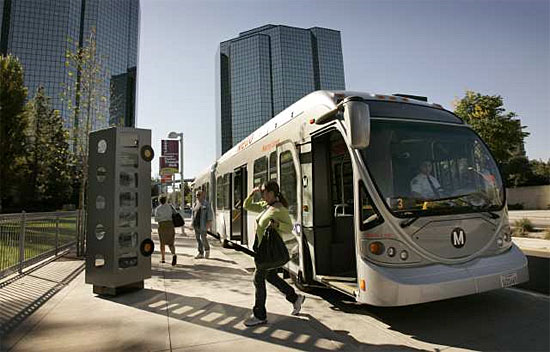A push to transform the popular Orange Line busway into the San Fernando Valley’s first light rail line may also jumpstart a broader examination of what the next chapter in L.A. County transportation could look like.
Metro’s Board of Directors next week will consider a motion to study options for improving the Orange Line, along with the possibility of connecting the Orange, Red and Gold Lines with Burbank and Bob Hope Airport. But that motion—by L.A. City Councilmember Paul Krekorian, Mayor Eric Garcetti, Glendale City Councilman Ara Najarian, Supervisor Zev Yaroslavsky and Duarte Mayor John Fasana—has now prompted a related push to create a roadmap to update Metro’s long term plans for the entire county.
Taken together, both concepts, if approved by the agency’s full board, could begin to give shape to the list of projects that might be included in potential new transit sales tax measure that could be on the 2016 ballot.
“It has to be part of a transparent, inclusive and innovative long range planning process from which a new sales tax ballot initiative should emerge,” said Santa Monica Mayor Pam O’Connor, who proposed the countywide amendment along with Lakewood Councilmember Diane Dubois and Supervisor Don Knabe at Metro’s Planning and Programming Committee meeting this week.
The current push to investigate upgrades to the Orange Line comes after Governor Jerry Brown recently signed into law a bill permitting ground-level rail in the busway’s corridor.
Some have argued that other, less costly improvements are the best way to improve the Orange Line—which is carrying nearly twice the people originally projected and has been reaching capacity during rush hours.
But Coby King, board chairman of the Valley Industry and Commerce Association, the primary backer of the new state legislation, said converting the bus line to rail is the best way to serve the Valley’s 1.77 million residents.
“The problem is that the Orange Line has become a victim of its own success,” King said. “We believe that rail is the answer. Let’s do the objective study and let the chips fall where they will and we can make a decision on the facts—and a certain amount of equity.”
King added that Measure R, the original 2008 half-cent sales tax measure to fund transit projects, brought 36 miles of new rail to other parts of the county but left the Valley with none. For the region to support a new tax measure, additional rail lines for the Valley would have to be a part of the equation, he said.
At the committee meeting, Metro CEO Art Leahy weighed in on the big picture as well as the specific concerns of Valley residents.
“Without a doubt the number of projects is going to exceed the amount of money a measure is going to generate, so at some point we are going to have to sit down with the subregions and talk turkey about what goes in,” Leahy said.
Posted 7/17/14







